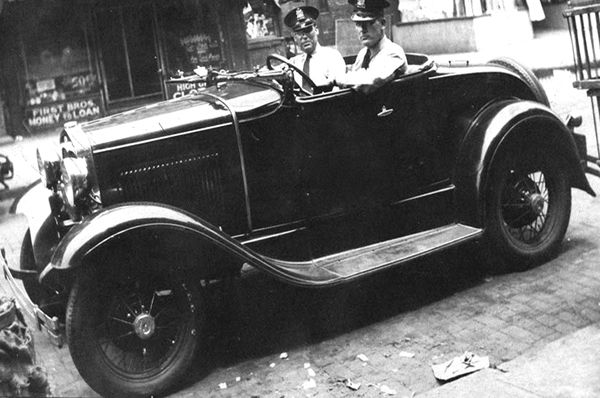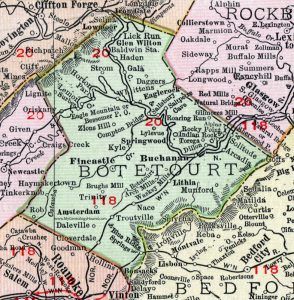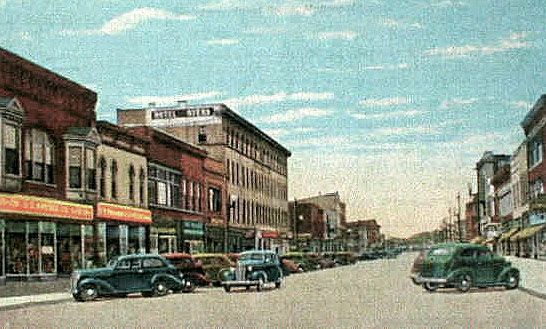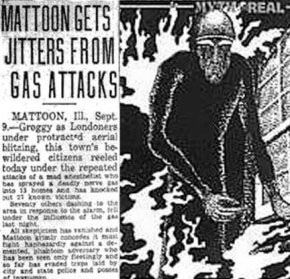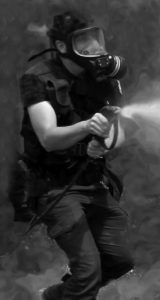 In the 1930s and 1940s, there were accounts of a “Mad Gasser” operating in two locations. The first occurred in Botetourt County, Virginia, in 1933-1934. The second was in Mattoon, Illinois, in 1944. Also known as the “Anesthetic Prowler” and the “Phantom Anesthetist,” these names were given to the person or people believed to be responsible for a series of gas attacks perpetrated against area residents. The identity of this shadowy character, who was infecting peoples’ homes with a foul-smelling odor, has never been determined.
In the 1930s and 1940s, there were accounts of a “Mad Gasser” operating in two locations. The first occurred in Botetourt County, Virginia, in 1933-1934. The second was in Mattoon, Illinois, in 1944. Also known as the “Anesthetic Prowler” and the “Phantom Anesthetist,” these names were given to the person or people believed to be responsible for a series of gas attacks perpetrated against area residents. The identity of this shadowy character, who was infecting peoples’ homes with a foul-smelling odor, has never been determined.
The first attack occurred on December 22, 1933, near Haymakertown, Virginia, in the home of the Cal Huffman family. At about 10:00 p.m. Mrs. Huffman smelled something strange and soon became nauseated. She and the children then went to bed as the smell dissipated. However, the foul odor returned about 30 minutes later, and Mr. Huffman went to a neighbor to use the phone and call the police. The police arrived but could not determine the source of the smell and, by midnight, had left. At about 1:00 a.m., the mysterious gas appeared again, and all eight family members were affected, suffering from nausea, headache, and constriction of the respiratory system. Most stricken was 20-year-old Alice Huffman, and a doctor was summoned, who gave her artificial respiration to revive her.
Cal Huffman suspected the family had been attacked, and a neighbor reported seeing a shadowy figure running away from the house. The police once again investigated and, with the help of Dr. W.N. Breckinridge, were able to rule out ether, chloroform, and tear gas but could not determine the specific type of gas. Following leads that there may have been a prowler, they found the print of a woman’s shoe beneath a window.
Two days later, on December 24, another family living in Cloverdale suffered from various symptoms, including nausea, burning eyes, and weakness caused by gas. Clarence Hall, his wife, and two children came home at about 9:00 p.m. and, about five minutes later, smelled a strange odor. Mr. Hall became so weak he was staggering and swaying, and his nauseated wife had to drag him outside. Mrs. Hall experienced eye irritation for the next two days. The police were called, and Dr. Breckinridge assisted again in the investigation, noting that the gas “tasted sweet” with a trace of formaldehyde. Looking for a prowler, the police found that a nail had been pulled from one of the windows, and a neighbor reported having seen a figure with a flashlight near the Hall residence. Afterward, Clarence Hall sent his family to stay with friends and rounded up a group of neighborhood men who spent the remainder of the night searching for the gasser without success.
On December 27, the Roanoke Times reported: “Gas Attacks on Homes Continue.”
Little did they know that another attack would happen that very night at the home of A.L. Kelly and his mother in Troutville, Virginia. Kelly reported having seen a man and a woman driving back and forth in front of the Kelly home in a 1933 Chevrolet at about the time of the attack A neighbor managed to get a partial license plate number, but the police were unable to locate it.
The local media published several wild speculations regarding the attacks, and panic soon spread through the community. With guns in hand, men began to keep night vigils on their properties, and the Botetourt County Board of Supervisors offered a $500 reward for the capture of the nefarious anesthetist.
More attacks would occur throughout 1934, including:
The home of Homer Hylton in Fincastle was attacked on January 10, 1934. One of the residents reported having heard mumbling voices and someone attempting to open a window. Hylton’s neighbor, G.E. Poage, confirmed that he had also heard voices outside at approximately the same time.
On the same date, a Troutville man named G.D. Kinzie was also attacked.
On January 16, the home of F.B. Duval, near Bonsack, was attacked. As Duval ran from the house to use a phone, he saw a man run up to a parked car and speed away. The next day, the police again found prints of a woman’s shoes where the car had been parked.
On January 19, the gasser sprayed into a window of the Campbell home near Cloverdale. Mrs. Campbell, sitting near the window, saw the shade move and immediately became nauseous.
On January 21, the Howard Crawford house between Cloverdale and Troutville was attacked when Mr. and Mrs. Crawford entered their home. They were immediately overwhelmed by a cloud of gas.
On January 22, three separate attacks occurred in Carvin’s Cove at the homes of Ed Reedy, Raymond Etter, and George C. Riley. One of Mr. Etter’s sons claimed to see a figure disappearing from the direction of the house. George Riley immediately called his brother, an officer with the Roanoke Police Department. In no time, the police established roadblocks around the area, but the Mad Gasser escaped once again.
On January 23, Mrs. R.H. Hartsell and her family returned to their Pleasantdale Church home at 4:30 a.m., discovering the house was filled with gas.
With the gas attacks occurring regularly, the citizens of Botetourt County were in an uproar. Local men were sitting on their doorsteps or patrolling the roadways at night, armed with shotguns and rifles. The police expressed concern that “some innocent person passing a house or calling upon a neighbor may be wounded or killed through nervousness.” However, though they had believed that the gassings were the pranks of adolescents, they were forced to admit that the attacks were something more serious.
At about this time, the New York Times heard about the events and published a story under the headline: “Virginians Are Terrorized by Gas Thrower, Who Flees in Night After Making Victims Ill.”
The next day, members of the Virginia State Assembly voted to pass a bill calling for a maximum prison term of 10 years for anyone convicted of releasing noxious gasses in public or private places. If the incident caused injury, the gasser would be “deemed guilty of malicious wounding and punished with from between one and 20 years in the penitentiary in the discretion of the court.”
On January 25, the Gasser was foiled when after hearing his dog bark, Chester Snyder grabbed his shotgun and ran outside, firing a shot at a man fleeing from his house. Missing the man, Snyder called the police, who found footprints leading to the house and signs that the prowler had hidden behind a tree.
But the Mad Gasser continued his attacks. On January 28, the home of Ed Stanley in Cloverdale was hit. Frank Guy, a hired hand on the farm, reported seeing four men fleeing from the house. Two nights later, the gassers returned to the Stanley’s home but fled when Stanley heard a sound outside the window and went outside to confront his attacker.
By January 30, some citizens began to feel that “the whole gassing case is a mere hoax or figment of the imagination of reported victims.” The next day, Dr. S.F. Driver, who believed in the reality of the gasser, admitted at a meeting of the County Board of Supervisors that not all cases appeared to be genuine gassings. On at least one occasion, the offending fumes were traced to a coal stove. In attendance was Sheriff L.T. Mundy, who typified the mood by declaring himself a Doubting Thomas unless he got gassed himself.
The last attack occurred at A.P. Scaggs’s home in Nace on February 3. This time, the perpetrators may have used more gas, as the family was severely affected, prompting Sheriff Williamson to say: “No amount of imagination in the world would make people as ill as the Skaggs are.” This time, the mist caused more than nausea; the family suffered from convulsions and hysterical shrieking.
However, people were scared, and more attacks were reported, including 20 reports in nearby Roanoke County and several others in Lexington, about 30 miles away. While some of these may have been legitimate, most didn’t follow the pattern of the original attacks, lacked details, and were likely hysterical reactions to ordinary odors.
These later cases caused many in the area to believe that all of the “attacks” had been caused by normal household events, such as faulty chimney flues, and that the owners’ reactions were little more than panic and hysteria.
Finally, the local authorities released a statement saying that the Mad Gassers didn’t exist, that the gasses were caused by normal events, and that the panic was spread by out-of-control rumors. However, not all of the police officers, especially those close to the investigation, believed this.
Lacking tangible evidence of a culprit, the press also began to express suspicion, as evidenced by an editorial in the Roanoke Times proclaiming: “Roanoke Has No Gasser.” The editorial stated: “This newspaper has so believed in the gasser’s nonexistence from the first, but it seemed best to permit the police to go ahead and investigate without whatever handicap they might be under were cold water to be thrown on their search in advance.”
The “Mad Gasser of Botetourt County” was never found.
Curiously, similar attacks began in Mattoon, Illinois, 11 years later, when more than two dozen cases of gassings were reported to police over two weeks. In many cases, the victims also reported sightings of a suspected assailant, who was said to have been a thin, black-clad prowler.
The first attack occurred on August 31, 1944, at the home of Urban Raef, who was awakened in the morning by a strange odor. Both he and his wife were nauseated and felt weak. Additionally, Mr. Raef suffered from vomiting, and Mrs. Raef was partially paralyzed.
Another report in the early morning of the next day said that a young mother living in a neighboring home also found herself paralyzed, and her daughter was coughing.
The next evening, a woman named Mrs. Bert Kearney was awakened by a strong, sweet odor around 11:00 p.m. As the odor became stronger, she began to lose feeling in her legs. She called out to her sister, Mrs. Ready, who was also in the house. Mrs. Ready determined that the smell was coming from a bedroom window, which was open at the time. The police were contacted, but no evidence of a prowler was found.
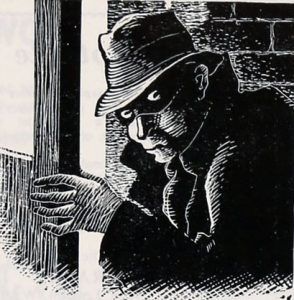 At around 12:30 a.m., Bert Kearney returned home from working as a taxi driver and found a man lurking outside one of the windows. The man fled, and Mr. Kearney later described the prowler to the media, stating that he was tall, thin, dressed in dark clothing, and wore a tight-fitting cap. In the meantime, Mrs. Kearney reported suffering from a burning sensation on her lips and throat. An investigation showed that the prowler’s motive was probably robbery. However, local newspapers reported that the incident was the first attack by the “Mad Gasser of Mattoon.”
At around 12:30 a.m., Bert Kearney returned home from working as a taxi driver and found a man lurking outside one of the windows. The man fled, and Mr. Kearney later described the prowler to the media, stating that he was tall, thin, dressed in dark clothing, and wore a tight-fitting cap. In the meantime, Mrs. Kearney reported suffering from a burning sensation on her lips and throat. An investigation showed that the prowler’s motive was probably robbery. However, local newspapers reported that the incident was the first attack by the “Mad Gasser of Mattoon.”
In the days that followed, several “attacks” were reported, but none of the victims could provide a description of the prowler, and no clues were found by the police who investigated.
On the night of September 5, Carl and Beulah Cordes returned to their home around 10:00 p.m., where they discovered a piece of white cloth on their porch. Picking up the cloth and smelling it, Beulah became extremely ill, suffering from a swollen face and a burning sensation in her mouth and throat, and began to vomit. She also reported feeling weak and experiencing partial paralysis of her legs. The police were called and took the cloth into evidence, an old skeleton key, and an empty tube of lipstick, which they found on the porch. The authorities concluded that a prowler had probably been trying to break into the house.
The same night, another incident was reported at the home of Mrs. Leonard Burrell, who said she had seen a stranger break in through her bedroom window and then attempt to gas her.
The next day seven reports were made, one of which saw a prowler they believed to have been the gasser. Many of these people complained of a sickeningly sweet odor that caused them to become sick and slightly paralyzed.
On September 7, Miss Frances Smith and Miss Maxine Smith reported they had seen a blue vapor and heard a motorized buzzing sound believed to be from gassing machinery. Between September 8 and September 13, seven more reports were made of reported attacks. In the last report, Bertha Burch described the gasser as a woman dressed as a man, and a woman’s footprints were found at the scene.
Public concern over these alleged gassings quickly rose, and the local authorities summoned FBI agents from Springfield to become involved in the case. Armed citizens soon took to the streets, patrolling at night for the “Mad Gasser.”
But the presence of the FBI didn’t calm the nerves of local residents, and rumors began to fly that the attacker was an escapee from an insane asylum or was a mad scientist testing his equipment.
During these events, local newspapers ran alarmist articles about the reported attacks, and it was probably the newspapers who were behind the “Gasser hysteria.”
By September 12, local police had received so many false alarms, mostly from citizens believing that they smelled gas or that they had seen a prowler, they announced that the entire incident was likely the result of explainable occurrences exacerbated by public fears. After the announcement, the gasser reports declined, and newspaper accounts took a more skeptical tone.
Though there is no evidence that the “mad gasser” attacks in Virginia and Illinois were perpetrated by the same person(s), there are similarities, including the accounts of woman’s shoe prints, the “attacks” often being made through a window, and the smelling of strange odors followed by symptoms of coughing, nausea, and vomiting. In both cases, victims quickly recovered from their symptoms and suffered no long-term effects.
Today, these cases are generally believed to be cases of mass hysteria.
However, many maintain that the Mad Gasser actually existed, though his motive remains unknown. Some have speculated that the gasses were caused by industrial pollution. Others have wilder ideas, such as paranormal activity, crazed scientists, the government testing a new vapor-based weapon, or a deranged WWI veteran.
In the end, we will likely never know.
© Kathy Alexander/Legends of America, updated November 2022.
Also See:
Sources:
Appalachian History
Chittum, Matt, Roanoke Times, May 2002
Mysterious Universe
Prairie Ghosts
Wikipedia


